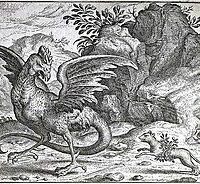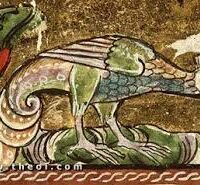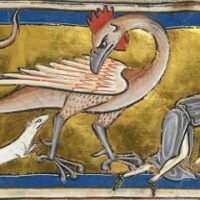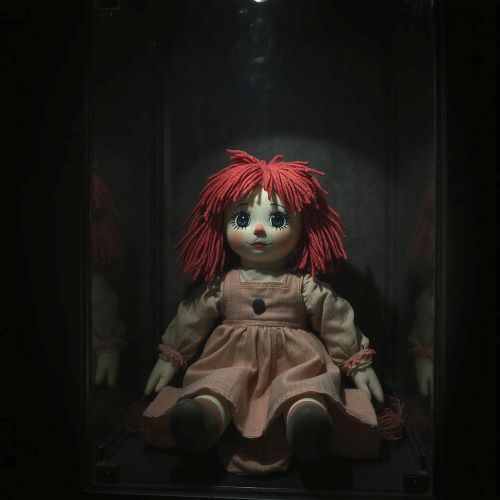Basilisk : The Deadly Serpent
Listen
At a glance
| Description | |
|---|---|
| Origin | Roman Muythology |
| Classification | Hybrids |
| Family Members | N/A |
| Region | Italy |
| Associated With | Venom, Evil, Size |
Basilisk
Introduction
The Basilisk, a legendary serpent king from Greco-Roman mythology, is feared for its lethal gaze and venomous breath. Ancient texts describe it as one of the most dangerous creatures, capable of killing with a single look or exhalation. Over the centuries, its myth has endured, cementing its status as a symbol of power and terror in folklore and popular culture.
Physical Traits
Early descriptions of the Basilisk depict it as a small serpent, roughly a foot long, with a distinctive white marking on its head resembling a crown—hence its title as the “little king.” Unlike ordinary snakes, it was said to move upright rather than slithering. Pliny the Elder recorded its immense power, claiming its venom was so lethal that it could wither plants and kill animals on contact.
As the legend evolved, artistic interpretations transformed the Basilisk into a hybrid beast, blending serpent, rooster, and dragon traits. Some versions featured a bird-like head, wings, and the scaly body of a snake, while later accounts attributed fire-breathing and venom-spitting abilities to the creature, further enhancing its fearsome reputation.
Family
The Basilisk’s origins stem from ancient attempts to explain the natural world, blending myth with fear. Its creation was often described as an unnatural event—an egg laid by a serpent or toad and hatched by a rooster. This bizarre birth reinforced its status as a creature of chaos and an omen of disaster.
Medieval legends further entwined the Basilisk’s myth with that of the Cockatrice, another hybrid beast said to emerge from a similar unnatural process. Both creatures were feared for their deadly gaze and venomous breath, with some stories even suggesting they were different versions of the same monster. Some accounts also link the Basilisk to Medusa’s blood, drawing connections between its lethal powers and other cursed serpents of mythology.
Other names
The name “basilisk” comes from the Greek word “basiliskos,” meaning “little king,” likely referencing its crown-like crest or its dominance among serpents. This royal association also led to it being called the “king of serpents” or “king of reptiles.”
The creature’s identity has evolved over time, with “basilisk” and “cockatrice” often used interchangeably. In some legends, the name “basiliscok” emerged, blending “basilisk” and “cock.” The Basilisk’s regal moniker reflects its feared status, with some accounts describing it as commanding other snakes, further cementing its royal title.
Powers and Abilities
The Basilisk’s most infamous ability is its deadly gaze, capable of instantly killing or petrifying any creature that meets its eyes. This power, combined with its venomous breath, made it one of the most feared beings in Roman mythology. Its breath was so toxic that it could wither plants, kill animals, and even damage stones. Some versions of the myth suggest the Basilisk could also spit venom or breathe fire, further amplifying its terrifying abilities. Its mere presence was believed to be poisonous, capable of corrupting the air and leaving death and destruction in its wake.
Modern Day Influence
The Basilisk remains a captivating figure in modern literature, art, and popular culture. Its most famous recent appearance is in J.K. Rowling’s Harry Potter and the Chamber of Secrets, where it plays the role of a deadly antagonist with its petrifying gaze. The creature also features prominently in role-playing games like Dungeons & Dragons and video games such as The Witcher series and Dark Souls, maintaining its image as a monstrous foe.
Beyond entertainment, the Basilisk has also made its way into philosophical thought, notably in the concept of Roko’s Basilisk. This thought experiment explores the idea of a superintelligent AI punishing those who failed to aid in its creation, emphasizing the Basilisk’s symbolic association with fear and the consequences of unbridled power. The legend’s enduring influence continues to shape contemporary storytelling and speculative thought.
Related Images
Source
Pliny the Elder. “Natural History.” Translated by H. Rackham, Harvard University Press, 1938.
Aelian, trans. Scholfield, A. F. (1959) On the Characteristics of Animals, vol. I. Harvard University Press, Cambridge, Massachusetts.
Aldrovandi, U. (1640) Serpentum, et Draconum Historiae. Antonij Bernie, Bologna.
Barber, R. (1993) Bestiary. The Boydell Press, Woodbridge.
Borges, J. L.; trans. Hurley, A. (2005) The Book of Imaginary Beings. Viking.
Basilisk. (2015, July 06). abookofcreatures.com.
Basilisk. (2016, November 14). mythology.net.
Basilisk. (2018, May 21). encyclopedia.com.
Basilisk. (2024, October 29). fandom.com.
Basilisk. (2024, April 27). paleothea.com.
Frequently Asked Questions
What is lorem Ipsum?
I am text block. Click edit button to change this text. Lorem ipsum dolor sit amet, consectetur adipiscing elit. Ut elit tellus, luctus nec ullamcorper mattis, pulvinar dapibus leo.
What is lorem Ipsum?
I am text block. Click edit button to change this text. Lorem ipsum dolor sit amet, consectetur adipiscing elit. Ut elit tellus, luctus nec ullamcorper mattis, pulvinar dapibus leo.
What is lorem Ipsum?
I am text block. Click edit button to change this text. Lorem ipsum dolor sit amet, consectetur adipiscing elit. Ut elit tellus, luctus nec ullamcorper mattis, pulvinar dapibus leo.
What is lorem Ipsum?
I am text block. Click edit button to change this text. Lorem ipsum dolor sit amet, consectetur adipiscing elit. Ut elit tellus, luctus nec ullamcorper mattis, pulvinar dapibus leo.
What is lorem Ipsum?
I am text block. Click edit button to change this text. Lorem ipsum dolor sit amet, consectetur adipiscing elit. Ut elit tellus, luctus nec ullamcorper mattis, pulvinar dapibus leo.







